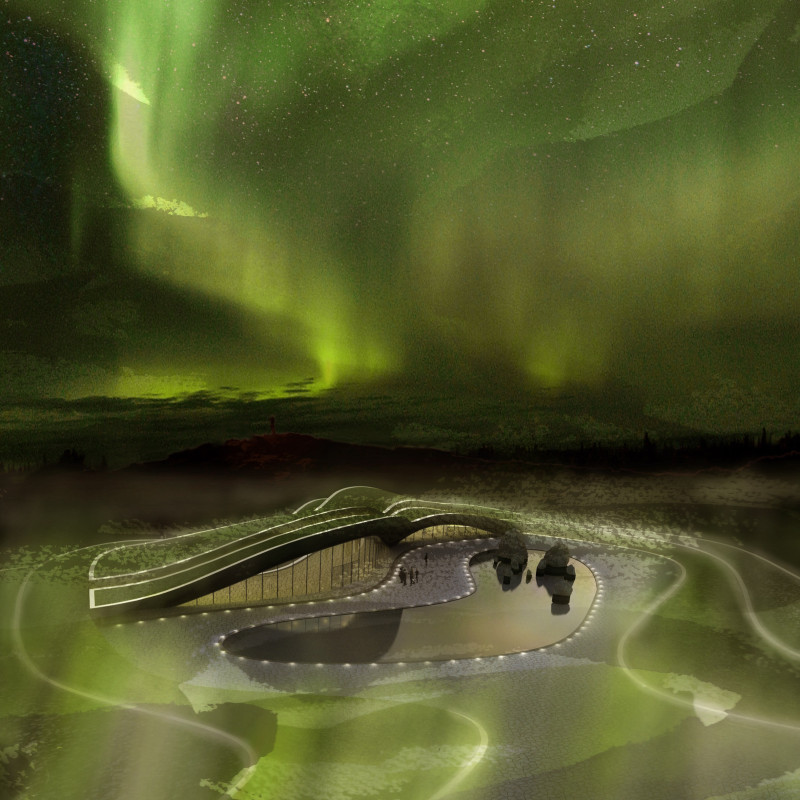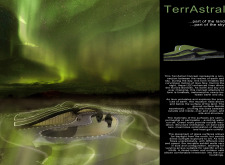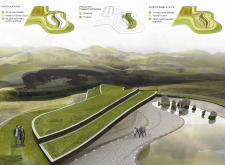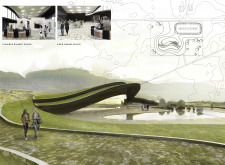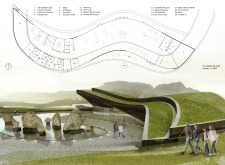5 key facts about this project
The primary function of this structure is to serve as a multifunctional space that accommodates various activities, thereby enhancing community interaction. This versatility is reflected in its layout, which includes both open and enclosed areas that facilitate a range of events, from public gatherings to private meetings. The design effectively balances openness with intimacy, providing areas for social interaction alongside quieter spaces for reflection and focus.
Several important architectural features contribute to the project's unique identity. The exterior façade employs a combination of materials, such as textured concrete, glass, and natural wood elements, which work cohesively to create a durable yet inviting atmosphere. The use of glass not only maximizes natural light within the interior but also provides a seamless connection between the indoors and the outdoors, encouraging occupants to engage with the surrounding landscape. This fluidity is a hallmark of contemporary design, reflecting an acknowledgment of nature as an integral component of the user experience.
Distinctive rooflines and overhangs extend the building’s boundaries, providing shade while accentuating the architectural silhouette. These features are not merely decorative; they serve practical purposes by enhancing energy efficiency through passive solar design. The careful attention to orientation ensures that the building remains comfortable throughout the different seasons, thereby reducing reliance on artificial climate control systems.
The interior design prioritizes natural materials, further reinforcing a connection to the environment. Warm wood finishes and strategically-placed greenery contribute to a calming atmosphere, suitable for both relaxation and productivity. Open floor plans foster collaboration and movement, allowing natural pathways to emerge as users navigate the space. This emphasis on user experience underpins every decision in the design process, ensuring that the facility does not just function as a building but as a community hub.
In terms of unique design approaches, the use of sustainable materials is particularly noteworthy. The project integrates recycled and locally-sourced materials wherever possible, reflecting a commitment to environmental stewardship. This not only minimizes the ecological footprint of the construction process but also supports local economies. Innovative design techniques, such as green roofs and rainwater harvesting systems, enhance the building's sustainability, underscoring the intention to create a model of responsible architecture.
The architectural designs employed in this project demonstrate a sensitivity to climatic conditions and local culture. The design adheres to the principles of biophilic architecture, integrating aspects of nature into the built environment to improve well-being and promote a sense of place. The interplay of light and shadow, enhanced by varied ceiling heights and window placements, creates dynamic spaces that evolve throughout the day.
Overall, this architectural project encapsulates a holistic approach to design that emphasizes usability, sustainability, and connection to the environment. By engaging thoughtfully with its surroundings and prioritizing user experiences, the project offers insights into contemporary architectural ideas. Readers are encouraged to explore the architectural plans, sections, and designs in detail to gain a comprehensive understanding of the layers and narratives embedded within this thoughtfully crafted building. Discover how the project stands as an embodiment of modern architecture that balances aesthetic appeal with functional integrity.


